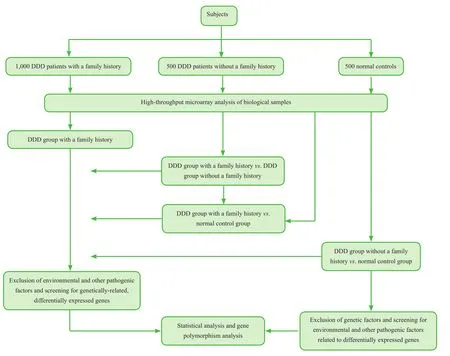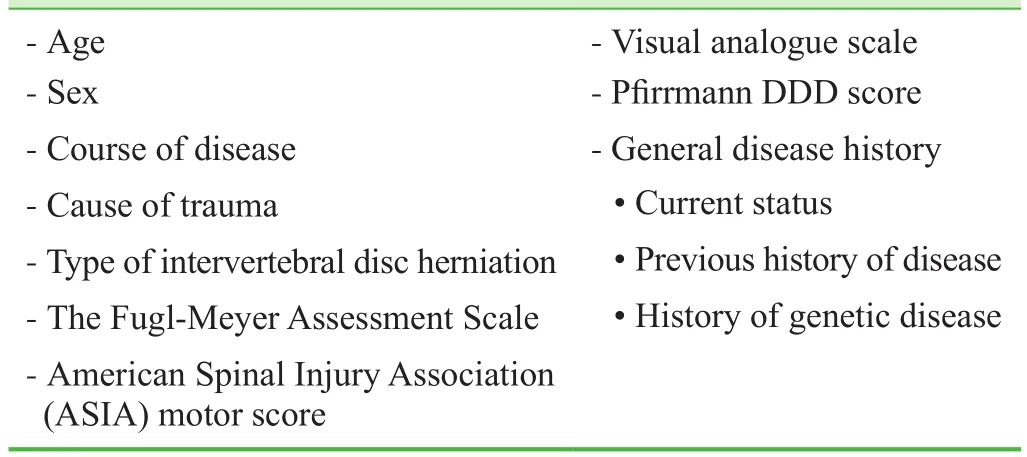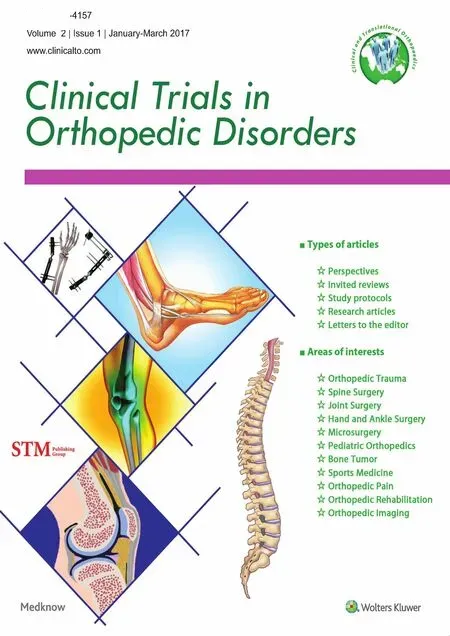Genetic risk factors of degenerative intervertebral disc disease:a case-control study
Qiang Shen *, Ji Qian, Qiang Wu, Ya-ping Luo, Hua Yu, Liang Zhu Hao Ding Jian Chen Wen-cheng Lu
1 Department of Orthopedics, Shanghai First People's Hospital, School of Medicine, Shanghai Jiao Tong University, Shanghai, China
2 Institute of Genetics, School of Life Sciences, Fudan University, Shanghai, China
3 System Biomedical Research Institute, Shanghai Jiao Tong University, Shanghai, China
4 Shanghai Nanxiang Hospital, Jiading District, Shanghai, China
5 Department of Orthopedics, Shanghai Traditional Chinese and Western Medicine Hospital, Shanghai, China
Introduction
The etiology of degenerative disc disease (DDD) is very complex and includes genetic, gender, age, environment and traumatic factors (Jackson and Isherwood, 1994; De Iure et al., 2014; Moriguchi et al., 2016). DDD is caused by interaction of genetic and environmental factors (Braun et al., 2014;Yang et al., 2015; De Arcangelis et al., 2016; Xiaogang et al.,2016). Patel et al. (2011) analyzed the health and genealogical data of 1,264 DDD patients from Utah, USA using the Utah Population Database and found a signi ficant relatedness of DDD patients. Furthermore, Battié et al. (2007, 2009) reported genetic factors to be high-risk factors for DDD, while Kepler et al. (2013) found several genes to be closely associated with DDD and that 75% of the risk of DDD is attributable to genetic factors. Matrix metalloproteinase 3 (MMP3),transforming growth factor β1 (TGF-β1), SRY-related high mobility group-box gene 9 (SOX 9), and sirtuin 1 (SIRT1)have recently been reported to be related to DDD (Zhou et al., 2016). A study by Nakamichi et al. (2016), suggested that MKX defects play an important role in the pathogenesis of intervertebral disc herniation. Identifying targets for treatment that correspond to different genotypes of DDD is very important for an individualized, multi-angle and multi-target approach. However, few in-depth studies have examined gene expression pro files of DDD pathogenic factors or explored underlying molecular mechanisms of the disease.
Therefore, we will establish a biological sample library and a database of DDD patients with a family history of the disease and who require surgical treatment. To identify pathogenic DDD genes, we will screen the patient database for genes that contain polymorphisms and/or are differentially expressed. This will enable identi fication of molecular markers for DDD and facilitate the development of drugs that target the genetic risk factors of DDD.
MethodS/deSign
Study design
This is a single-center, case-control study.
Study setting
This study will be performed in the Department of Orthopedics, Shanghai First People's Hospital, School of Medicine,Shanghai Jiao Tong University, China.
Study procedure
(1) Blood, urine and intervertebral disc tissue samples of DDD patients and healthy controls scheduled to receive surgical treatment or physical examination in the Shanghai First People’s Hospital, School of Medicine, Shanghai Jiao Tong University, will be collected in a systematic, standardized manner. Samples from 1,000 DDD patients with a family history, from 500 DDD patients without a family history,and from 500 healthy controls will be included in this study.(2) Gene expression variations will be compared among DDD patients with or without a family history and healthy controls. A total of 26,249 genes will be screened for differential expression.
(3) Genome-wide association analysis will be performed using high-throughput microarrays and single nucleotide polymorphism (SNP) microarrays and pooling (SNP-MAP)to identify SNP loci associated with DDD with a family history and that requires surgical treatment.
A flow chart of the study protocol is shown in Figure 1.
Study participants
Inclusion criteria
DDD patients with a family history and presenting with all of the following criteria will be included in this study:
· Patients with cervical spondylosis, cervical disc herniation, thoracic disc herniation or lumbar disc herniation and requiring surgical treatment
· Age 12-65 years
· Of either sex
· Having a family history of DDD
· Provision of written informed consent
Exclusion criteria
DDD patients with a family history and presenting with one of the following criteria will be excluded from this study:
· Malignant tumor
· Infection
· Cirrhosis, severe renal impairment, uremia or severe traumatic brain injury
· Disease of the hematopoietic system
· Severe osteoporosis, ankylosing spondylitis, rheumatoid arthritis, diffuse idiopathic osteoarthritis, or ossi fication of the posterior longitudinal ligament
Withdrawal criteria
DDD patients with a family history and presenting with one of the following criteria will be withdrawn from this study:
· Pregnancy
· Diabetes mellitus
· Non-surgical treatment
· Participation in other clinical trials
· Participation in the trial would be a potential hazard to the participant’s health
· Diagnosis of a genetic disorder in a family member
DDD patients without a family history will be included according to the inclusion criteria used for DDD patients with a family history, with the exception of no family history of DDD. Normal controls will be healthy persons who receive physical examination or require surgery for spine trauma in the clinic and will be age- and sex-matched.

Figure 1: Flow chart of the study protocol.
Baseline evaluation
Subject baseline data including demographic data and general disease history are shown in Table 1.
Sample size
In accordance with our experience, we hypothesized that the percentage of differentially expressed genes in DDD patients with or without a family history was 2% and 0.5%,respectively. Takingβ= 0.15 and power = 85% with a signi ficance level ofα= 0.05 (two-sided), the final effective sample size ofn= 984 per group was calculated using PASS 14.0 software (NCSS, Kaysville, UT, USA). If we assume a patient loss rate of 20%, we will require 1,181subjects per group, thus 3,543 subjects will be included.After screening against inclusion and exclusion criteria,2,000 subjects will be included in this study.

Table 1: Subject baseline data
Recruitment
DDD patients will be recruited from the wards of Shanghai First People’s Hospital, School of Medicine, Shanghai Jiao Tong University, China, and healthy persons receiving physical examination will be recruited from the hospital’s clinics between December 2016 and May 2017 through a recruitment advertisement on the hospital bulletin board.Potential participants can contact the project managerviatelephone or e-mail. After providing informed consent, these potential participants will be screened using the inclusion and exclusion criteria. A sample library and a database of the included patients will be established.
Randomization and blinding
A total of 2,000 subjects including DDD patients and healthy controls will be randomly selected to establish the sample library and database. Random grouping will not be used in this study. This study is an open trial. DDD patients, physicians, and assessors will not be blinded to treatment protocols.
Intervention measures
(1) Questionnaire: The investigators will help patients fill in theLiving Condition and Health Survey for Patients with Disc Degeneration Disease and Healthy Controlsquestionnaire. Survey items include sex, age, body height, body weight, occupation, history of neck and back trauma, and family history of cervical and thoracolumbar spine disease.
(2) Collection of blood and urine samples: Fasting blood samples will be collected for routine liver and kidney function tests. Routine blood tests, SNP identi fication and routine urine tests will be performed. All subjects will undergo routine X-ray examination and MRI of the spine to observe spine morphology.
(3) Harvesting of intervertebral disc tissue: Intervertebral disc tissue of patients who receive interbody fusion will be harvested. Residual blood attached to the tissue sample will be removed by three washes with PBS. The annulus fibrosus and the nucleus pulposus will be distinguished under a stereomicroscope and harvested, packaged, and numbered.The entire tissue harvesting and processing process will take less than 3 hours. The numbered tissue samples will be cryopreserved in liquid nitrogen.
(4) Gene sequencing: Total RNA will be extracted from degenerated and normal intervertebral disc tissues using the TRIzol method (normal intervertebral disc tissue will be obtained from the normal control group). Total RNA samples will be prepared for capillary electrophoresis and puri fication using a Bioanalyzer 2100 Capillary Electrophoresis System (Agilent). cDNA will be obtained by reverse transcription and cDNA libraries will be constructed according to the Illumina TruSeq RNA library preparation method. High-throughput sequencing of cDNA libraries will be performed using the Illumina HiSeq4000 platform.Processing of the sequence data will be performed using TopHat (ccb.jhu.edu/software/tophat/index.shtml) and Bowtie (http://bowtie-bio.sourceforge.net/bowtie2/index.shtml) software. Differentially expressed genes and noncoding RNA sequences will be identi fied from the transcriptome data by gene sequencing.
(5) SNP detection: Venous blood will be collected.Genome-wide association analysis will be performed using high-throughput microarray analysis and single nucleotide polymorphism microarrays and pooling (SNP-MAP) to identify the SNP loci associated with DDD patients with a family history of the disease.
Outcome measures
Primary outcome measures
Among 26,249 genes assessed, the percentage of differentially expressed genes in DDD patients with or without a family history of the disease will be determined. Percentage of differentially expressed genes will be compared between DDD patients with and without a family history of the disease, between DDD patients with a family history of the disease and normal controls, and between DDD patients without a family history of the disease and normal controls (Figure 1). The number of differentially expressed genes in DDD patients with or without a family history of the disease will be determined according to the formula: percentage of differentially expressed genes(%) = number of differentially expressed genes/26,249× 100%. Higher values indicate greater difference in the number of differentially expressed genes relative to that in the normal control group.
Secondary outcome measures
· Sequence variation in differentially expressed genes:The differentially expressed genes and non-coding RNA sequences will be identi fied from the transcriptome data by gene sequencing.
· SNP genotyping: SNP loci will be identi fied by genomewide association analysis and genotyped. The association of each SNP locus with disease will be analyzed.The strength of association, odds ratio (OR) value and 95% con fidence interval (CI) will be calculated. The genotypes and allele frequencies of the differentially expressed genes will be calculated.
· Routine liver and kidney function tests: Aspartate aminotransferase, alanine aminotransferase and urea nitrogen and creatinine levels will be measured to evaluate patients’ liver and kidney function.
· Routine blood tests: White blood cells, red blood cells,platelets and hemoglobin levels will be measured to determine whether patients suffer from anemia.

Table 2: Timing of trial outcome measures
· Routine urine tests: Turbidity, pH value, red blood cells,white blood cells, epithelial cells, urinary casts, protein,speci fic gravity and glucose will be measured.
· Morphology of degenerated intervertebral disc: The morphology of degenerated intervertebral discs will be observed by X-ray examination or MRI.
The timing of outcome measures is shown in Table 2.
Data collection, management, analysis and open-access
(1) During the trial, a clinical investigator designated by the sponsor will perform on-site inspection visits to the hospital on a regular basis to ensure that the entire study protocol is strictly followed and the data correctly obtained. The clinical researchers participating in this trial will be professionally trained. The recording methods and evaluation criteria will be uni fied. The entire study will be strictly performed according to the study protocol. The Study Quality Management Program is shown in Appendix 1.
(2) All contents on the case report forms will be recorded truthfully and carefully to ensure all contents are true and reliable.
(3) Researchers will record data carefully, including rechecking case report forms, original medical notes, and written informed consent. All data related to this study will be preserved by Shanghai First People’s Hospital, China.
(4) All results and findings will be rechecked to con firm reliable data and to ensure that each conclusion is based on original data. Corresponding data management measures will be used in the clinical trial and data processing stages.Anonymized trial data will be published at www. figshare.com.
Statistical analysis
Gene expression pro filing data analysis will be performed by the Statistics Team of the Institute of Genetic Medicine.Data processing will be performed by classi fication analysis,clustering analysis and feature gene mining methods using ArrayTools software. Normally distributed measurement data will be expressed as the mean ± standard deviation,with minimums and maximums. Non-normally distributed measurement data will be expressed as lower quartile (q1),and median and upper quartile (q3). Numerical data will be expressed as a percentage. The Pearson chi-squared test will be used to compare the percentage, genotype and allele frequencies of differentially expressed genes between groups.Multiple logistic regression analysis will be performed to analyze the risk factors of DDD, with calculation of theORand 95%CIof each factor (or gene). The signi ficance level will beα= 0.05 (two-sided).
Trial Status
Patient recruitment and sample collection is ongoing.
Discussion
Significance of this study
In this study, we will include DDD patients with a family history of the disease. We will obtain bioinformatic data(based on genome, epigenome and transcriptome data)and other biological and clinical trial data, establish multilevel disease models and clarify the regulatory mechanism of genetic risk factors in the occurrence, development and turnover of DDD.
Limitations and strengths of this study
Sample sizes in each group will not be 1:1 matched. The sample size in the normal control group is too small. There are too many strati fication factors in fluencing the trial results. There exists sample selection bias. All these will influence the reliability of the trial results.
This study aims to identify precise molecular diagnostic markers and to identify drug targets for the development of targeted therapy that will lead to a breakthrough in DDD treatment.
Appendix 1 Study quality management program
Clinical investigators will be professionally trained in the use of theLiving Condition and Health Survey for Patients with Disc Degeneration Disease and Healthy Controlsquestionnaire and in clinical information collection,sample harvesting, preservation and transportation, with the purpose of reducing error rates of genetic information investigation and clinical data collection.
The sample library and databases will be managed and maintained by trained specialists.
Genetic analysis experiments will be performed in state-level key laboratories by graduate students majoring in molecular biology under the guidance of professional technicians.
The study was registered with the Chinese Clinical Trial Registry for quality monitoring.
Declaration of patient consent
The authors certify that they will obtain all appropriate patient consent forms. In the form the patients will give their consent for their images and other clinical information to be reported in the journal. The patients understand that their names and initials will not be published and due efforts will be made to conceal their identity, but anonymity cannot be guaranteed.
Conflicts of interest
None declared.
Author contributions
QS conceived and designed the study protocol and wrote the manuscript. Other authors assisted in study conduction. All authors approved the final version of this paper.
Plagiarism check
This paper was screened twice using CrossCheck to verify originality before publication.
Peer review
This paper was double-blinded and stringently reviewed by international expert reviewers.
Battié MC, Videman T, Levalahti E, Gill K, Kaprio J (2007) Heritability of low back pain and the role of disc degeneration. Pain 131:272-280.
Battié MC, Videman T, Kaprio J, Gibbons LE, Gill K, Manninen H,Saarela J, Peltonen L (2009) The twin spine study: contributions to a changing view of disc degeneration. Spine J 9:47-59.
Braun J, Baraliakos X, Regel A, Kiltz U (2014) Assessment of spinal pain. Best Pract Res Clin Rheumatol 28:875-887.
De Arcangelis V, Strimpakos G, Gabanella F, Corbi N, Luvisetto S,Magrelli A, Onori A, Passananti C, Pisani C, Rome S, Severini C, Naro F, Mattei E, Di Certo MG, Monaco L (2016) Pathways implicated in tadala fil amelioration of duchenne muscular dystrophy. J Cell Physiol 231:224-232.
De Iure F, Chehrassan M, Cappuccio M, Amendola L (2014) Sitting imbalance cause and consequence of post-traumatic Charcot spine in paraplegic patients. Eur Spine J 23 Suppl 6:604-609.
Jackson A, Isherwood I (1994) Does degenerative disease of the lumbar spine cause arachnoiditis? A magnetic resonance study and review of the literature. Br J Radiol 67:840-847.
Kepler CK, Ponnappan RK, Tannoury CA, Risbud MV, Anderson DG (2013) The molecular basis of intervertebral disc degeneration. Spine J 13:318-330.
Moriguchi Y, Alimi M, Khair T, Manolarakis G, Berlin C, Bonassar LJ, Härtl R (2016) Biological treatment approaches for degenerative disk disease: a literature review of in vivo animal and clinical data. Global Spine J 6:497-518.
Nakamichi R, Ito Y, Inui M, Onizuka N, Kayama T, Kataoka K,Suzuki H, Mori M, Inagawa M, Ichinose S, Lotz MK, Sakai D,Masuda K, Ozaki T, Asahara H (2016) Mohawk promotes the maintenance and regeneration of the outer annulus fibrosus of intervertebral discs. Nat Commun 7:12503.
Patel AA, Spiker WR, Daubs M, Brodke D, Cannon-Albright LA(2011) Evidence for an inherited predisposition to lumbar disc disease. J Bone Joint Surg Am 93:225-229.
Xiaogang M, Quanshan H, Liping Z, Kaken H (2016) The expression of cytokine and its signi ficance for the intervertebral disks of Kazakhs. J Clin Lab Anal
doi:10.1002/jcla.22087.
Yang W, Yu XH, Wang C, He WS, Zhang SJ, Yan YG, Zhang J,Xiang YX, Wang WJ (2015) Interleukin-1β in intervertebral disk degeneration. Clin Chim Acta 450:262-272.
Zhou N, Lin X, Dong W, Huang W, Jiang W, Lin L, Qiu Q, Zhang X,Shen J, Song Z, Liang X, Hao J, Wang D, Hu Z (2016) SIRT1 alleviates senescence of degenerative human intervertebral disc cartilage endo-plate cells via the p53p21 pathway. Sci Rep 6:22628.
 Clinical Trials in Orthopedic Disorder2017年1期
Clinical Trials in Orthopedic Disorder2017年1期
- Clinical Trials in Orthopedic Disorder的其它文章
- Information for Authors -Clinical Trials in Orthopedic Disorders
- MRI appearance of injured ligaments and/or tendons of the ankle in different positions: study protocol for a single-center,diagnostic clinical trial
- Effect of periprosthetic fracture on hip function after femoral neck-preserving total hip arthroplasty: study protocol for a prospective, single-center, self-controlled trial with 2-year follow-up
- New bone fixation plate for the repair of avulsion fracture of the tibial attachment of the posterior cruciate ligament: study protocol for a prospective, open-label, self-controlled, clinical trial
- Risk factors for ligamentum flavum hypertrophy in lumbar spinal stenosis patients from the Xinjiang Uygur Autonomous Region, China: protocol for a retrospective, single-center study
- Effect of tourniquet use during total knee arthroplasty on global inflammatory cytokine changes associated with ischemiareperfusion injury
